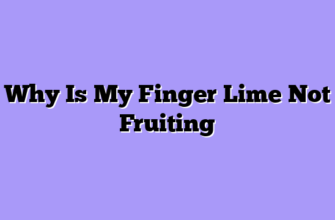After 15 years of coaxing exotic fruits from reluctant soil, I’ve developed what my wife calls an “unhealthy obsession” with the citrus family. But among all the Meyer lemons, Buddha’s hands, and yuzu that populate my experimental plots, nothing has fascinated me more than the contrast between conventional limes and their peculiar Australian relative—the finger lime.
How My Finger Lime Affair Began
It was a sweltering July morning in 2015 when I first encountered finger limes at a specialty produce conference in California. A fellow grower from Australia had brought these strange, finger-shaped fruits that locals down under call “citrus caviar.” When he split one open and showed me the tiny, glistening pearls inside, I was instantly hooked. Three weeks later, I had secured my first finger lime saplings—a considerable investment at $120 per tree.
“You’ve lost your mind,” my farm manager said when he saw the price tag. Today, he’s the one most protective of our finger lime grove.
What Exactly Is a Finger Lime?
The finger lime (Citrus australasica) is native to the rainforests of Australia’s east coast, where Aboriginal peoples have harvested them for thousands of years. They call them “Gulalung” in some indigenous languages. Unlike conventional limes (Citrus latifolia for Persian limes or Citrus aurantifolia for Key limes), these curious fruits have adapted to life in the understory of dense forests.
The finger lime isn’t just different inside—everything about it challenges what we think we know about citrus:
- They grow on thorny, shrubby trees that can reach 20 feet tall but often remain much smaller
- The fruits range from 2-4 inches long and really do look like stubby, knobby fingers
- Colors vary widely—from deep purple to bright red, pale green to yellowish
- Break one open, and instead of juice sacs, you find hundreds of tiny, pearl-like vesicles that pop in your mouth like caviar
I learned the hard way that they’re significantly more cold-sensitive than traditional limes. After losing half my initial planting to an unexpected frost, I constructed a microclimate area with wind barriers and overhead protection that’s helped immensely.
The Growing Game: Chalk and Cheese
Growing conventional limes is straightforward compared to their finicky Australian cousin. My Persian lime trees (often called Bearss limes in American markets) are vigorous, productive, and relatively forgiving. Meanwhile, finger limes have taught me the virtue of patience.
Here’s what I’ve discovered through trial, error, and occasionally talking to my plants when nobody’s around:
| Characteristic | Conventional Lime | Finger Lime |
|---|---|---|
| Growth rate | Fast – 2-3 feet per year | Slow – often less than 1 foot annually |
| Time to first harvest | 2-3 years | 3-5 years |
| Yield per mature tree | 30-40 pounds | 5-15 pounds |
| Watering needs | Moderate, consistent | Less frequent, good drainage essential |
| Soil preference | Well-draining, pH 6-7 | Very well-draining, pH 5.5-6.5 |
| Hardiness | Damaged below 30°F | Damage possible below 32°F |
| Sunlight | Full sun | Part shade to full sun |
| Pest sensitivity | Moderate | High (especially to scale insects) |
| Harvest season | Multiple harvests possible | Single, concentrated harvest |
“These little divas,” as my daughter calls our finger limes, demand attention that conventional limes simply don’t. But the exclusivity is part of the appeal—I can grow Persian limes reasonably well in Zone 9, but producing quality finger limes consistently puts me in a small club of growers.
The Taste Test: Not Just Different Shapes
The first time I served finger limes to friends at a farm-to-table dinner, everyone expected them to taste like conventional limes—just in a different package. They couldn’t have been more surprised.

Would you believe the difference is so pronounced that chefs who visit the farm can identify each variety blindfolded? One described the finger lime as “lime flavor with eucalyptus undertones and a touch of forest floor.” I wouldn’t go quite that far, but there’s definitely something distinctive happening.
The Market Reality: Worth Their Weight in Gold?
Let’s talk dollars and cents, because farming exotic fruits isn’t just about agricultural fascination—it’s my livelihood. Conventional Persian limes sell wholesale in my region for around $1-2 per pound. On a good year, that’s profitable enough to justify the orchard space.
Finger limes? They command anywhere from $25-45 per pound wholesale. That’s not a typo.
Why the astronomical difference? Three main factors:
- Production challenges: They’re difficult to grow and yields are significantly lower
- Harvesting intensity: Each fruit must be hand-picked at precise ripeness, and their thorns make this a painful process
- Market scarcity: Domestic production remains extremely limited, and restaurant demand continues to grow
I sell about 80% of my finger lime harvest directly to high-end restaurants within a 200-mile radius. The remaining 20% goes to specialty grocers who market them as premium ingredients, where they retail for nearly $1 per individual fruit.
Is the profit margin better than conventional limes? Absolutely. But the labor intensity and specialized growing conditions mean they’re not the gold rush they might appear to be on paper.
In the Kitchen: How We Use Them Differently
My family has become accustomed to having both varieties available, and we use them in completely different ways.
For conventional limes:
- Squeezing into drinks and cocktails
- Adding acidity to marinades and dressings
- Using the zest in baking
- Preserving in salt for Middle Eastern dishes
For finger limes:
- Topping oysters and seafood (my son’s restaurant sources exclusively from our farm for this purpose)
- Garnishing desserts where the pearls remain intact
- Adding textural pops to salads
- Making specialty preserves that showcase the intact vesicles
The greatest revelation came when my wife developed a finger lime vinaigrette where the pearls remain suspended throughout the dressing. When you drizzle it over greens, each bite offers tiny bursts of acidity rather than uniform flavor. It’s become our signature farm product, and we can barely keep it in stock.
Future Prospects: Where Both Are Heading
After dedicating significant acreage to both conventional and finger limes, I’m convinced they each have strong futures—just in different markets.
Persian and Key limes will remain kitchen staples for American cooks, with steady demand and increasing interest in organic options. My conventional lime production remains consistent and profitable, especially as awareness of fresh lime benefits over bottled juice increases.
Finger limes occupy a different niche entirely. They’re experiencing the trajectory that once belonged to ingredients like truffles or saffron—moving from obscurity to chef obsession to broader consumer awareness. Five years ago, I had to explain what they were to everyone. Now, about half of visitors to our farm stand recognize them immediately.
The challenge with finger limes isn’t demand—it’s scaling production efficiently without sacrificing quality. I’ve experimented with different growing systems, including an espalier method that makes harvesting less painful (literally—those thorns are vicious) and increases yield per square foot.
Looking Back, Looking Forward
If you’d told me twenty years ago that I’d become deeply invested in an Australian citrus variant that looks like a gherkin and pops like caviar, I’d have questioned your sanity. Yet here I am, proudly showing visitors our finger lime greenhouse before anything else on the farm.
Conventional limes will always have their place in our operation. They’re reliable, versatile, and deeply embedded in culinary traditions worldwide. But finger limes represent what I love most about specialty fruit cultivation—the opportunity to introduce people to entirely new flavors and textures.
“Why grow what everyone else grows?” has become something of a mantra for me. When a renowned chef visits our farm and experiences that moment of discovery—the tiny pop of citrus pearls against the backdrop of a fresh seafood dish—I’m reminded why we persist through the challenges.
Both fruits may share a family name, but the conventional lime and the finger lime tell different stories. One speaks to tradition, reliability, and classic applications; the other whispers of innovation, exclusivity, and culinary adventure. I’m grateful to have both narratives unfolding in the soil of our farm.
And if you’re wondering which I reach for when mixing my end-of-day gin and tonic? I’ll never tell—though the tiny green pearls floating in my glass might give it away.








